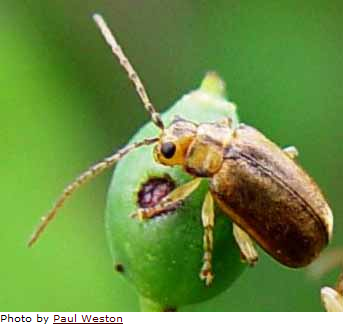Want to help in the fight with Emerald Ash Borer? We’re looking for First Detectors who want to:
- Become a local expert who can answer EAB biology and management questions.
- Aid in the community preparedness planning process
- Engage others as volunteers to monitor for EAB, conduct street tree inventories, collect ash seed and educate about the issues surrounding Emerald Ash Borer
These training sessions will go over in-depth details of EAB biology, signs and symptoms, hosts, control and management, reporting, and resources through presentations and hands-on field activities at near-by EAB infested locations. Materials have been created by Cornell University and the Northeast Plant Diagnostic Network. These workshops are supported by a Northeastern IPM Center- IPM Partnership Grant.
Who should take this training?
Anyone that is concerned about EAB. But especially if you are a: Cornell Cooperative Extension employee; Cornell Cooperative Extension volunteer (Master Gardener, Master Forest Owner, Master Naturalist, 4-H Leader); PRISM partner (Partnerships for Regional Invasive Species Management); SWCD or NRCS employee; Arborist; Forester; Logger; Landscaper; Planner; Environmental Educator; Municipal Employee; or a Community Volunteer
First Detectors can give back.
There is huge public demand for answers on what to do about EAB. As a trained EAB First Detector, you’ll have those answers. We hope that you will be able to help the greater community by sharing your EAB knowledge, participating in community preparedness activities, or monitoring for EAB.
Workshop Details
May 14, 2012. 1-5 pm at the Agroforestry Resource Center (CCE Columbia and Greene) 6055 Route 23, Acra, NY 12405.
May 18, 2012. 1-5 pm at Reinstein Woods Nature Preserve and Environmental Education Center (Erie County), 93 Honorine Dr. Depew, NY 14043.
May 29, 2012. 1-5 pm at Cornell Cooperative Extension of Monroe County, 249 Highland Avenue
Rochester, NY 14620.
All sessions are FREE, but registration is required. Please register at http://tinyurl.com/7b9l3ep.
These courses are eligible for: 2.5 ISA CEUs, 0.5 NYLT TLC elective credits, and 4 CNLP credits.
NYS DEC Pesticide & SAF CF credits have been applied for. Please stay tuned to the Events section of http://nyis.info/eab for updates.
Questions, email Rebecca at jrh45@cornell.edu or call 607-334-5841 x 16
J Rebecca Hargrave
Horticulture and Natural Resources Extension Educator, Cornell Cooperative Extension of Chenango County
99 N Broad St, Norwich, NY 13815 phone: 607-334-5841 x 16 fax: 607-336-6961
http://www.cce.cornell.edu/chenango jrh45@cornell.edu










